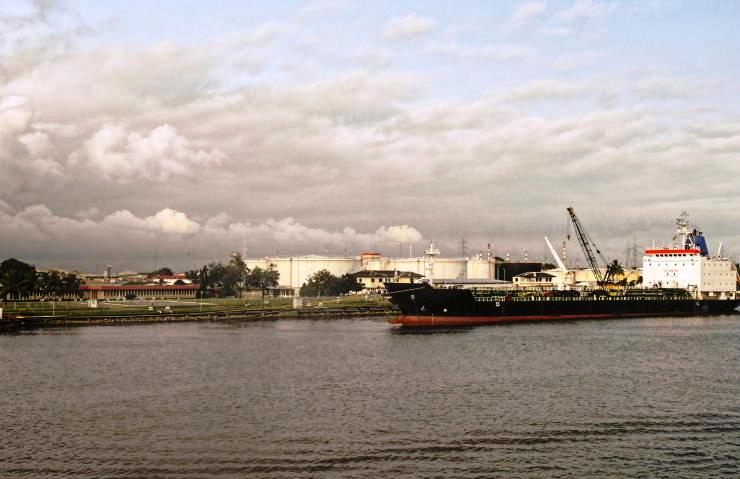China’s Strategy for Port Development in Africa.

Chinese firms are present in over a third of all African port developments, some of which could be used for expanded Chinese naval presence on the continent.
Chinese state-owned firms are active stakeholders in an estimated 78 ports across 32 African countries as builders, financiers, or operators. Chinese port developments are concentrated in West Africa,
with 35 compared to 17 in East Africa, 15 in Southern Africa,
and 11 in North Africa.
With a total of 231 commercial ports in Africa, Chinese firms are present in over a third of Africa’s maritime trade hubs. This is a significantly greater presence than anywhere else in the world. By comparison, Latin America and the Caribbean host 10 Chinese-built or operated ports, while Asian countries host 24.
In some sites, Chinese firms dominate the entire port development enterprise from finance to construction, operations, and share ownership. Large conglomerates like China Communications Construction Corporation (CCCC) will win work as prime contractors
and hand out sub-contracts to subsidiaries like the China Harbor Engineering Company (CHEC).
This is the case in one of West Africa’s busiest ports, Nigeria’s Lekki Deep Sea Port. CHEC did the construction and engineering, secured loan financing from the China Development Bank (CDB), and took a 54-percent financial stake in the port which it operates on a 16-year lease.
China gains as much as $13 in trade revenues for every $1 invested in ports. A firm holding an operating lease or concession agreement reaps not only the financial benefits of all trade passing through that port but can also control access. The operator determines the allocation of piers, accepts or denies port calls, and can offer preferential rates and services for its nation’s vessels and cargo. Control over port operations by an external actor, accordingly, raises obvious sovereignty and security concerns. This is why some countries forbid foreign port operators on national security grounds.
Chinese firms hold operating concessions in 10 African ports. Despite the risks over loss of control, the trend on the continent is toward privatizing port operations for improved efficiency. Delays and poor management of African ports are estimated to raise handling costs by 50 percent over global rates.
China’s strategic priorities involving foreign ports are laid out in China’s Five-Year Plans. The current Five-Year Plan (2021-2025) talks about a “connectivity framework of six corridors, six routes, and multiple countries and ports” to advance Belt and Road construction. Notably, three of these six corridors run through Africa, landing in East Africa (Kenya and Tanzania), Egypt and the Suez region, and Tunisia. This reinforces the central role that the continent plays in China’s global ambitions. The Plan articulates a vision to build China into “a strong maritime country”—part of its larger rejuvenation as a Great Power.
China’s focus on African port development was facilitated by the “Go Out” strategy, a government initiative to provide state backing – including massive subsidies – for state-owned firms to capture new markets, especially in the developing world. One Belt One Road (known internationally as the Belt and Road Initiative) – China’s global effort to connect new trade corridors to its economy – is a product of Go Out, sometimes referred to as “Go Global.”
Africa has been a central feature of the Go Out strategy, where port infrastructure was a major impediment to expanding Africa-China trade. Heavy Chinese government subsidies and political backing encouraged Chinese shippers and port builders to seek footholds on the continent. They benefited from robust government and party-to-party ties that China cultivated over time. All told, Africa became highly attractive to China’s state-owned enterprises, despite the many risks of doing business on the continent.
China’s port development strategy has also linked up Africa’s 16 landlocked countries via Chinese-built inland transport infrastructure, facilitating the movement of goods and resources to market
and vice versa. These have come to be called One Belt One Road connector projects.
China’s growing footprint in African ports also advances Chinese military objectives. Some of the 78 port sites that Chinese firms are involved in can berth the Chinese People’s Liberation Army (PLA) Navy
vessels based on their specifications while others can dock PLA Navy vessels on port calls.
The PLA Navy has called on the following African ports in recent years: Abidjan (Côte d’Ivoire), Gentil (Gabon), Casablanca (Morocco), Tamatave (Madagascar), Maputo (Mozambique), Tincan (Nigeria), Pointe-Noire (Republic of Congo), Victoria (Seychelles), Durban (South Africa), Simon’s Town (South Africa).
Some of these ports have also been staging grounds for PLA military exercises. These include the ports of Dar es Salaam (Tanzania), Lagos (Nigeria), Durban (South Africa), and Doraleh (Djibouti). The latter involved exercises with landlocked Ethiopia.
Chinese troops have also made use of naval and land facilities for some of their drills, including Tanzania’s Kigamboni Naval Base, Mapinga Comprehensive Military Training Center, and Ngerengere Air Force Base—all built by Chinese firms. The Awash Arba War Technical School has served a similar purpose in Ethiopia, as have bases in other countries. In total, the PLA has conducted 55 port calls and 19 bilateral and multilateral military exercises in Africa since 2000.
Beyond direct military engagements, Chinese firms handle military logistics in many African ports. For example, Chinese state-owned enterprise Hutchison Ports has a 38-year concession from the Egyptian Navy to operate a terminal at the Abu Qir Naval Base.
There has been much speculation and debate over which of these ports might be the location for additional Chinese military bases besides Doraleh in Djibouti. While the available data and decision criteria are limited, certain measures provide some indicators.
As seen in the development of Doraleh (in which Chinese firms held 23 percent of the stakes), size of Chinese shareholding of a port is an inadequate factor on its own. Nonetheless, it is noteworthy that Chinese firms hold 50 percent stakes in three West Africa ports: Kribi, Cameroon (66 percent), Lekki, Nigeria (52 percent), and Lomé, Togo (50 percent).
Previous PLA engagement is another consideration. Of the 78 African ports in which Chinese firms are known to be involved, 36 have hosted PLA port calls or military exercises. This demonstrates that they have the design features to support Chinese naval flotillas, making them potential candidates for future PLA navy bases.
Not all of these have the proven physical specifications to berth PLA vessels, however. This considers factors such as number of berths, berth length and size, and capabilities for fueling, replenishment,
and other logistics.
Beyond the physical specifications are political considerations such as strategic location, the strength of a government’s party-to-party ties with China, its ranking within China’s system of partnership prioritisation, membership in China’s One Belt One Road Initiative network, and levels of Chinese foreign direct investment and high-value Chinese assets. Commonly ignored but no less important is the strength and capacity of public opinion to shape local decisions.
Considering just the design features, seven ports stand out for the likelihood of being employed for future Chinese military use: Luanda (Angola), Doraleh (Djibouti), Mombasa (Kenya), Walvis Bay (Namibia), Lekki (Nigeria), Victoria (Seychelles), Dar es Salaam (Tanzania).
The heightened pace of China’s military drills and naval port calls in Africa in recent years has generated increased attention to these issues in the African media, think tanks, and policy discussions. The growing militarisation of China’s Africa policy is stoking concerns about the implications of more foreign bases in Africa. Some are concerned that Chinese basing scenarios could inadvertently draw African countries into China’s geopolitical rivalries, undermining the continent’s stated commitment to nonalignment. (Africa Centre for Strategic Studies) – (Photo: the harbour of Abidjan in Ivory Coast.123rf)



